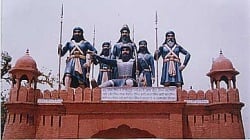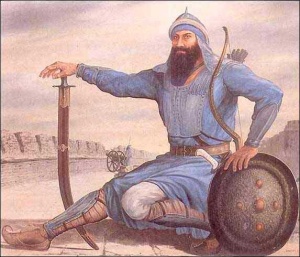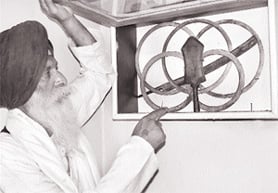Battle of Sirhind
Sirhind the town located in Punjab India, which was the unfortunate witness to the the martyrdom of the two younger sons or chotta sahibzada of Guru Gobind Singh in 1704. Wazir Khan, its Subadar (Governor) at the time had vowed to finish off the Sikhs, 'root and branch', after they had left Anandpur Sahib.
Though the Sikhs had been given a promise of safe passage to Punjab, a promise written in the flyleaf of their holy book, the Qur'an which included the seal of the Emperor Aurangzeb. The Sikhs who were half starved and weakened by the many months that the the Mughals and Hindu hill chieftains had laid siege to Anandpur they put up a spirited defense at the Sarsa, killing many of their attackers. At Chamkaur thousands of attackers failed to capture Guru Gobind Singh no doubt making those who hoped to kill him including Wazir Khan furious.
The frustrated Wazir Khan must have been delighted when the two younger sons of Guru Gobind Singh, 9 year old Baba Zorawar Singh and and 6 year old Baba Fateh Singh along with their paternal grandmother Mata Gujri ji fell into his custody, after being betrayed by a trusted former member of the Guru's household. They had been separated from the Guru and his Sikhs, in the confused battle while crossing the rain swollen frigid waters of the Sarsa.
After they refused the Subedar's offers of power and wealth, if only they would accept Islam, Wazir Khan ordered his men to brick them into a wall while still alive, thinking that the children would surely choose Islam over such a gruesome death, but even this failed to change the resolve of the Guru's two youngest sons. When even the bricks enclosing the young Princes tumbled to the ground Wazir Khan ordered their execution.
| Battle of Sirhand | |||||
|---|---|---|---|---|---|
| Date: May 12- May 14 1710 | |||||
| Location: Chappar Chiri | |||||
| Result Sikh Victory The Establishment of The First Sikh empire From Lahore to Delhi
52 lakh Rupees were looted | |||||
| Belligerents | |||||
| Khalsa | Mughal | ||||
| Commanders | |||||
| Banda Singh
Baj Singh Binod Singh Fateh Singh Ram Singh Karam Singh Dharm Singh |
Wazir Khan KIA
Suchanand KIA
| ||||
| Casualties | |||||
| 20,000 | 60,000 | ||||
The anger of the Sikhs
Learning of the deaths of the sahibzades, the Sikhs were keen to avenge their deaths and that of the Guru's mother, the wife of the beloved Guru Tegh Bahadur. Such savagery and the loss of youngest of the Guru's sons at Wazir Khan's orders, would lead to the destruction of Sirhind four years later.
After the death of Aurangzeb, Guru Gobind Singh had rallied the Sikhs even lending his support to one of Aurangzeb's sons Muazzam to defeat his brothers in their fight for the Muslim throne. Four years later travelling with a band of Singhs, Guru Gobind Singh accompanied Muazzam now installed as Bahadur Shah on a trip to the Deccan. After separating from the Mughal column, Guru Gobind Singh and some of his devotees went looking for the camp of a Hindu faqir named Lachman Das who was soon to take Pahul from the Guru's hands, becoming Banda Singh Bahadar along the bank of the Godavari.
Guru's time to depart had arrived
After the Guru was attacked by two Pathan assassins, said to have been sent by Wazir Khan (who was fearful of the growing friendship between the Guru and the Moghul Emperor). Though the assassins were killed, one had managed to stab the Guru in his side. The wound was dangerous, but the European doctor that Bahadur Shah had sent to the Guru's aide had managed to repair the damage and the Guru was said to be recovering well.
Days later the Guru while stringing a new bow, he opened the wound again, but this time the wound could not be closed, realizing that he could not return to counter the tyranny of Wazir Khan and his like the Guru sent Banda Bahadur to Punjab to suppress the tyranny of the rulers and punish Wazir Khan and free the Punjab and India of Mughal rule, which had long repressed the peace loving peoples of the continent including the Sikhs. In October, 1708, Banda marched towards Punjab along with a band of 25 Sikhs and a hukamnama, which enjoined upon the Sikhs to assemble under his banner. As Banda reached Delhi, thousands gathered under his command.
Banda Singh starts his mission
After subjugating Sonepat, Samana, Shahbad, Mustafabad, Kapuri and Banur, Banda led his troops to take on Wazir Khan, who also came out of Sirhind to confront the Khalsa army. Whereas the Mughal army had cannons and cavalry, the Sikhs only had swords, spears and small arms. The two armies clashed at Chapar Chiri on May 12, 1710. The main battle was fought on the plain of Chappar Chiri which falls in Kharar Tahsil on Banur - Kharar Road.
Sirhind was not an easy target to capture for Banda. It was the seat of the provincial capital. It's Nawab, Wazir Khan was one of the pillars of the Mughal empire with a huge army under his command. He had been in power for many years and had accumulated considerable wealth and position. Khan made extensive arrangements to meet the challenge of Sikhs under Banda. He proclaimed a "Jihad" - a religious war against the Sikhs, the accursed infidels or Kafirs.
The preparation for battle
A large number of Gazis or religious warriors from far and wide responded to his call. He collected his noted faujdars, zamindars and sardars. He had a large number of elephants, mounted gunnery, archers, lancers and swordsmen. Banda had no artillery, no elephants and not even sufficient supply of good horses. He and his soldiers only possessed long spears, arrows and swords.
The organization and regrouping of troops before they are launched into battle is one of the fundamentals of war. This was an area in which Banda Bahadur was not lacking. So he organized his troops into two assaulting groups (Jathas). In the first group were the Malwais put under the command of Fateh Singh, Karam Singh, Dharam Singh and Ali Singh. The Majhel Singhs formed the second group under the command of Baba Binod Singh, Bhai Baj Singh, Ram Singh and Sham Singh.
Warir Khan marches out for battle

Photo from: Gurdwara Mehdiana Sahib
Wazir Khan marched out in person with his large army with elephants in front to check the advance of the Sikhs. Banda ordered his commanders to advance and himself sat on a mound nearby to watch and direct the operation. The moment the battle started, the irregulars comprising robbers took to their heels. It is with regard to these people that Irvine in his book "Later Mughals" remarks, "At the first shook, the Sikhs, after a feeble resistance turned and fled." A sanguinary battle now ensued. The Sikhs shouted the war cry of 'Sat Sri Akal', whereas, the war cry of 'Ali, Ali' , was raised by the Muslims. The entire atmosphere resounded with these war cries.
First, the Muslim artillery caused a heavy destruction of lives. Realizing this disadvantage, the soldiers of Guru Kalgidhar decided to do or die for a noble cause and sallied forth en-masse towards the cannon. Though they suffered heavy casualties, they succeeded in snatching the cannon. They then started hand-to-hand fight. Even then, the enemy was at an advantage.
Heat of the Battle
Then Baj Singh, Second-in-command, rushed to Banda, who had remained aloof so far, with a request to play his role. Banda then rushed forward to the forefront of his army. To quote Sohan Singh. "Then rose he (Banda) like a hungry lion from his cave and sprang upon the army like a bolt from the blue. His appearance very much encouraged the Khalsa, whereas it struck a general terror among the enemy. Just as Julius Caesar, all of a sudden and with a single attack had turned the tables of fortunes against the hitherto obviously winnings Gauls, the irresistible Banda, with a single sally changed the whole scene."
Encouraged by the advent of their leader on the battlefield. the Singhs fell in a compact body upon the Muhammadans. The onslaught was so penetrating that it became difficult for the enemy to stand it. Khazan Singh holds that "when the battle was raging, a strong storm set in and with that the Singhs rushed at the enemy with drawn swords and put them to flight. "Money and baggage, horses, elephants, fell" says Khafi Khan, "into the hands of the infidels (Singhs) and not a man of the army of Islam escaped with more than his life and the clothes he stood in.
Finally, the Khalsa overcome the enemy
Horsemen and footmen in great numbers fell under the swords of the infidels who pursued them as far as Sirhind. During that confusion, Wazir Khan fell to the sword of Fateh Singh. After a pitched battle fought for two days the Sikhs raised a victory cry and razed Sirhind to the ground. Banda formally took control of Sirhind locality on May 14, 1710.
This was the first territorial conquest of the Sikhs, which placed them in possession of the entire country south of the Satluj to the neighbourhood of Delhi. On 24 May 1710, Banda Singh Bahadur entered Sirhind city after it had been cleared of enemy fighters. And with this conquest, now included in the Patiala District became the first centre of an independent Sikh Kingdom in the Punjab and it fired the common people of the country with hopes of greater successes.
Declaration of Sikh rule
On 27 May, 1710 at huge diwan (gathering) was organised in Sirhind city. At this gathering, Banda Singh Bahadur announced the establishment of Sikh rule in Sirhind city and an end to the tyranny of the Mughal rule which had spread terror and injustice to the people of the region.
Banda Bahadur repaired the old imperial fort of Mukhlispur occupied by him at the time of conquest of Sadhaura, gave it the name of Lohgarh and established his capital there.
Timeline
- 12 May, 1710 Battle of Chaaper Chheri in which Nawab Wazir Khan was killed.
- 14 May, 1710 Banda Singh Bahadhur conquered Sirhind.
- 24 May, 1710 Baba Banda Singh Bahadur enters Sirhind city.
- 27 May, 1710 Baba Banda Singh Bahadur announces the establishment of Sikh rule in Sirhind
The site of historic war
Harbans Singh Virdi tribuneindia.com
ON the Banur-Kharar road just a few kilometres off Landran lies a small village which has so far remained hidden in a maze of history. In appearance Chapar Chiri resembles any small Punjab village, with a few pucca houses devoid of any basic necessities of life. Yet this was the place where the battle of Sirhind, called the mother of all battles, was fought and won by the Sikhs under the command of Banda Singh Bahadur in 1710. It is at this place that having sacked Sirhind, the Sikhs for the first time had a foretaste of freedom. It gave the Sikh nation a shot in the arm and a feeling that they had as much right to rule as any Mohammedan ruler or an Afghan invader. The succeeding years saw the Sikhs fighting nothing short of political emancipation of their territory.
The Sirhind victory not only brought to end the decadent Mughal rule, but also established a brief but important four-year Sikh rule in Punjab. The Sikhs for the first time became rulers of the land of five rivers.
Despite its historical importance, Chapar Chiri remained in the dustbin of history for over two centuries. It would have been lost to the ravages of time for ever, but for the efforts of one Inder Singh of Sohana, who discovered the place in 1950. Realising its historical importance, he built a small kuctha kotha and looked after the place in the best possible way with his limited means. After his death, a survivor of the famous Jaito-ka-Morcha, Ishar Singh, took over the control of the place and built a modest gurdwara in 1955.
According to “mukh sevadar’ Prem Singh, Ishar Singh served the place for 40 long years till his death in 1988. Ishar Singh, an illiterate, ex-Army man, looked after the place with devotion. He made every effort to accord the place the recognition it deserved. It was during his time that political leaders of the stature of Master Tara Singh addressed the Sikh sangat at Chapar Chiri. Yet the place failed to attract the attention of political leaders, who found little time to lay even a brick in memory of those selfless soldiers who had died for their faith.
The intensity and magnitude of the battle can be gauged from the fact that though the Sikhs won against heavy odds, they had lost 20,000 men in action. The Wazir Khan army had lost more than 60,000 troops. Interestingly, where the dead Sikhs were cremated en masse, a memorial stands even today on the premises of Jyoti Sarup Gurdwara in Sirhind. However, the place where they had fought and died, no war memorial has ever been raised in their honour. A few years ago, a broken piece of a sword, a khanda made in 1694 and some other weapons were recovered from a well in the village.
Chapar Chiri has about 45-50 houses and 500 inhabitants. A panchayat committee consisting of Balwant Singh, Dalip Singh, Zora Singh, Prem Singh, Daljit Singh, Harnek Singh and a few others runs the gurdwara with its modest means. The gurdwara has about 18 acres of land, yet the committee has failed to mobilise resources to build a war memorial. When The Tribune team visited the place, it found the power cable disconnected at the sevadar’s house since the bill was not paid.
While the state can be blamed for not taking care of a great historic site, the panchayat committee has never thought of organising even a simple function on the battle anniversary, which falls on May 12. When quizzed on this, Prem Singh says that farmers at this point of time are busy in harvesting. Therefore, the committee holds a function every year in February in memory of all martyrs, including those of Nankana Sahib.
The place suffers from utter neglect. Till a few years ago, there was no school in the village. Now, the Bank of Punjab runs Guru Nanak Foundation School. A new building is coming up to house the gurdwara, for which kar seva is being undertaken by Harbans Singh of Delhi. But there is yet no sign of a war memorial for the unsung Sikh heroes.
The villagers demand that a function should be held on May 12 every year to remember those who had laid down their lives. Prem Singh says the SGPC should open a kirtan training centre at this place so that people are taught Gurbani. In addition, the village needs better infrastructure. Earlier, Chapar Chiri was part of Kharar subdivision, now it is part of Mohali. Since for every errand villagers have to rush to Mohali, they need better means of travel and communication.
Mr Balwant Singh, who had been the village sarpanch for 15 years, says they have approached both the state government as well as the SGPC for financial help, but none has contributed as a result of which neither the memorial nor any function has been held on May 12. “We have also tried to get grants through the panchayat committee but in vain. The government or the SGPC must take care of such a historic site”.
Mr Prithipal Singh, a Sikh scholar based in Ludhiana, laments the absence of any war memorial at the site. “It is surprising that Chapar Chiri has escaped the notice of the Sikhs, the successive governments and even the SGPC for so long.”
Another Sikh scholar, Prof Tajinder Singh of Jalandhar, echoes similar sentiments. “Not only a war memorial should be raised in memory of those who had realised the Sikh dream but also the weapons recovered from the site should be preserved for future generations. After all, the Sirhind victory marked a new epoch in Sikh resurgence,” he says.
See also
External Links
- Unsung Sikh hero Banda Bahadar The Sunday Tribune, June 17, 2007


